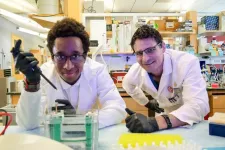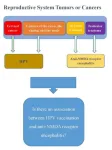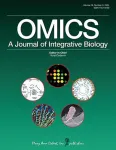(Press-News.org) Researchers at the University of Arizona College of Medicine – Tucson were awarded a $1.8 million grant by the National Institute of General Medical Sciences, a division of the National Institutes of Health, to learn how human papillomavirus makes its way to a cell’s nucleus.
Human papillomavirus, or HPV, which can cause warts and certain cancers, has been with us since the dawn of humanity and causes about 5% of cancers worldwide. It also is an important source of information about human biology, according to Samuel K. Campos, PhD, an associate professor of immunobiology at the University of Arizona College of Medicine – Tucson and member of the BIO5 Institute.
“These viruses take advantage of pathways the cell has and tweak them. What better cell biologists to teach us how cells work than the viruses that have evolved with us for eons?” Campos said about how HPV illuminates the inner workings of our bodies. “Follow the biology of the virus, and we’ll learn some cool new cell biology.”
Campos said there are more than 600 known strains of human papillomavirus, with more yet to be discovered. His lab mainly focuses on HPV16, the type that causes the majority of cervical, anal and head and neck cancers.
HPV has found its niche in certain types of epithelial cells, which cover our body as skin and line our body cavities as mucous membranes. The virus moves from the lower layers of the epithelium to the upper layers and once it’s close to the surface, replication kicks into high gear as it prepares for to leave one body and infect another.
“We are constantly shedding dead skin — it just comes off our body,” Campos said. “That is how HPVs have so successfully spread throughout the human population.”
HPV’s genes are packaged in a protein shell. The Campos Lab focuses on the role of one of these shell proteins, L2, which can insert itself into the membranes of our cells, like a key into a lock, and let itself inside. Upon entry, the virus is escorted along a twisted path to the nucleus, where it hijacks the cell to make copies of itself.
Campos said his lab’s prior research revealed that, from the cell’s point of view, L2 looks like another part of the cell.
“We learned that the virus is really sneaky,” Campos said. “L2 can actually stick through the cell membrane without rupturing it, and HPV stays hidden behind these membranes. It’s able to avoid sensors that detect danger signals, like a wolf in sheep’s clothing.”
Previous research published by the Campos Lab and other groups suggested that HPV may be able to hide until the cell’s machinery whirs into action during cell division, at which point it sheds its “sheep’s clothing” and hitches a ride to the nucleus.
“Once the virus has successfully delivered its DNA genome into the nucleus, it can begin expressing its own genes to take over the cell,” Campos said. “That will lead to immune evasion, alteration of the cell cycle, the generation of new viral particles and transmission to another host. If the virus sticks around long enough, these infections can sometimes alter the cell in a way that leads to cancer.”
The five-year, R35 grant Campos received is reserved for scientists with outstanding research records and the potential to make major contributions to their fields. It gives investigators the flexibility to follow their research in whatever direction it takes them. The grant will support the Campos Lab as researchers attempt to uncover how HPV takes advantage of cell division to move from its hiding place in the cell to the nucleus.
“It’s a complete black box. It’d be really neat to figure that out,” Campos said, adding that following the virus’s path will shed light on the intricacies of cell division and how things move in and out of cells.
These unknowns are what keep Campos coming to work each day.
“It’s tough and it’s frustrating, but it’s also satisfying — like solving a puzzle,” he said. “You don’t know where the science will take you. You don’t know what the ending is going to be. That’s exciting.”
This research is supported by the National Institute of General Medical Sciences, a division of the National Institutes of Health, under award No. 1R35GM152143-01.
END
$1.8M NIH grant will help researchers follow a virus on its path to the nucleus
New research into HPV could shed light on the intricacies of cell division and how things move in and out of cells.
2024-04-23
ELSE PRESS RELEASES FROM THIS DATE:
Follow-up 50 years on finds landmark steroid study remains safe
2024-04-23
A new study has found there are no adverse long-term cardiovascular health consequences for the now-adult children of mothers who were given corticosteroids because they were at risk of early birth in a landmark trial conducted in Auckland, New Zealand, 50 years ago.
The Auckland Steroid Study by obstetrician Professor Graham ‘Mont’ Liggins and paediatrician colleague Dr Ross Howie from 1969 to 1974 in Green Lane Hospital, Auckland, found that two corticosteroid injections given to pregnant women at risk of early (preterm) birth halved the incidence of respiratory distress in the babies and significantly reduced neonatal deaths.
Co-author of the new study, Dr ...
Active military service may heighten women’s risk of having low birthweight babies
2024-04-23
Active military service may heighten a woman’s risk of having a low birthweight baby, suggests a review of the available scientific evidence published online in the journal BMJ Military Health.
The findings highlight the need for more research specifically focused on women in the armed forces, and their reproductive health in particular, conclude the study authors.
Worldwide, increasing numbers of women are on active service in their country’s armed forces. The UK Armed Forces, for example, has set a target of 30% female representation by 2030. And more and more countries are deploying women in combat ...
Significant global variation in national COVID-19 treatment guidelines
2024-04-23
National clinical guidelines for the treatment of COVID-19 vary significantly around the world, with under-resourced countries the most likely to diverge from gold standard (World Health Organization; WHO) treatment recommendations, finds a comparative analysis published in the open access journal BMJ Global Health.
And nearly every national guideline recommends at least one treatment proven not to work, the analysis shows.
Significant variations in national COVID-19 treatment recommendations have been suspected since the advent of the pandemic, but these haven’t been ...
Cost increasingly important motive for quitting smoking for 1 in 4 adults in England
2024-04-23
Health concerns are still the primary motive for more than half of those who say they want to stop smoking in England, but cost is now a key factor for more than 1 in 4, finds an analysis of national survey responses, published in the open access journal BMJ Public Health.
Given this shift in thinking, making much more of the potential savings to be had might encourage more people to stub out for good, suggest the researchers.
Health concerns are generally the primary motive for people trying to stop smoking, with social and ...
Is there an association between HPV vaccination and anti-NMDA receptor encephalitis?
2024-04-22
Anti-N-methyl-d-aspartate (Anti-NMDA) receptor encephalitis is an acute
autoimmune disorder that develops both neurological symptoms and psychiatric
symptoms, including hallucination, cognitive disturbance, epilepsy, movement
disorder, and impaired consciousness. This disease may be misdiagnosed at the early
stage as a psychosis disease because of primary psychiatric symptoms. The
misdiagnosis may delay appropriate therapeutic intervention. Most patients with
anti-NMDA receptor encephalitis respond to immunotherapy [1, 2].
The pathology of this disease is ...
Blood-based multi-omics guided detection of a precancerous pancreatic tumor
2024-04-22
A new case report published in the peer-reviewed OMICS: A Journal of Integrative Biology describes how longitudinal multi-omics monitoring (LMOM) helped to detect a precancerous pancreatic tumor and led to a successful surgical intervention. Click here to read the article now.
The patient had undergone annual blood-based LMOM, in which 143 endogenous metabolites in serum and a panel of 140 proteins in plasma were measured. David Wishart, PhD, from the University of Alberta, ...
Eye-opener: Pupils enlarge when people focus on tasks
2024-04-22
Working memory is one of the brain’s executive functions, a skill that allows humans to process information without losing track of what they’re doing.
In the short term, working memory allows the brain to complete an immediate task, like loading the dishwasher. Long term, it helps the brain decide what to store for future use, such as whether more dishwasher soap will be needed.
University of Texas at Arlington researchers know that working memory varies greatly among individuals, but they aren’t sure exactly why. To better understand, Matthew Robison, assistant professor of psychology, and doctoral student Lauren D. Garner conducted an experiment to see if ...
Current Nanomaterials and Current Analytical Chemistry have been indexed in Ei Compendex
2024-04-22
Bentham Science is pleased to announce that two of its journals, Current Nanomaterials and Current Analytical Chemistry, have been officially indexed in the EI Compendex.
EI Compendex is one of the most comprehensive subject-specific literature databases, encompassing high-quality research articles from prominent engineering and applied science journals worldwide.
Current Nanomaterials, a leading peer-reviewed journal devoted to the exploration and dissemination of cutting-edge research in the field of nanomaterials, covers a broad spectrum ...
International balance of power determined by Chinese control over emerging technologies, study shows
2024-04-22
The fierce competition between China and the United States of America for control of emerging technologies such as AI and 5G will determine the international balance of power, a new study says.
Developments in quantum computing, the Internet of Things, and Big Data have transformed the global order and have led to new alliances and dynamics, the analysis shows.
Forming new allies has become imperative for the USA because the country cannot address the challenges posed by China in isolation. This has involved sharing sensitive advanced technologies with national security and ...
New writing therapy helps late-stage cancer patients face biggest fears
2024-04-22
Imagine your greatest fear.
Now, write it down and tell it in first-person, as if it’s happening right now. Vividly describe what it looks, sounds, smells, tastes and feels like. Don’t hold back.
Such an exercise could be daunting for anyone, dredging up feelings we try to avoid. But for late-stage cancer patients struggling with anxiety and other mental health issues, it can be remarkably therapeutic, new CU Boulder research has found.
“It’s often easier to write about something traumatic than to speak it out loud, especially to someone ...
LAST 30 PRESS RELEASES:
Sleeping in on weekends may help boost teens’ mental health
Study: Teens use cellphones for an hour a day at school
After more than two years of war, Palestinian children are hungry, denied education and “like the living dead”
The untold story of life with Prader-Willi syndrome - according to the siblings who live it
How the parasite that ‘gave up sex’ found more hosts – and why its victory won’t last
When is it time to jump? The boiling frog problem of AI use in physics education
Twitter data reveals partisan divide in understanding why pollen season's getting worse
AI is quick but risky for updating old software
Revolutionizing biosecurity: new multi-omics framework to transform invasive species management
From ancient herb to modern medicine: new review unveils the multi-targeted healing potential of Borago officinalis
Building a global scientific community: Biological Diversity Journal announces dual recruitment of Editorial Board and Youth Editorial Board members
Microbes that break down antibiotics help protect ecosystems under drug pollution
Smart biochar that remembers pollutants offers a new way to clean water and recycle biomass
Rice genes matter more than domestication in shaping plant microbiomes
Ticking time bomb: Some farmers report as many as 70 tick encounters over a 6-month period
Turning garden and crop waste into plastics
Scientists discover ‘platypus galaxies’ in the early universe
Seeing thyroid cancer in a new light: when AI meets label-free imaging in the operating room
Neutrophil-to-lymphocyte ratio may aid risk stratification in depressive disorder
2026 Seismological Society of America Annual Meeting
AI-powered ECG analysis offers promising path for early detection of chronic obstructive pulmonary disease, says Mount Sinai researchers
GIMM uncovers flaws in lab-grown heart cells and paves the way for improved treatments
Cracking the evolutionary code of sleep
Medications could help the aging brain cope with surgery, memory impairment
Back pain linked to worse sleep years later in men over 65, according to study
CDC urges ‘shared decision-making’ on some childhood vaccines; many unclear about what that means
New research finds that an ‘equal treatment’ approach to economic opportunity advertising can backfire
Researchers create shape-shifting, self-navigating microparticles
Science army mobilizes to map US soil microbiome
Researchers develop new tools to turn grain crops into biosensors
[Press-News.org] $1.8M NIH grant will help researchers follow a virus on its path to the nucleusNew research into HPV could shed light on the intricacies of cell division and how things move in and out of cells.



